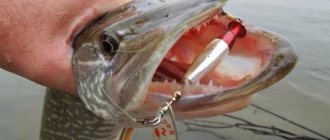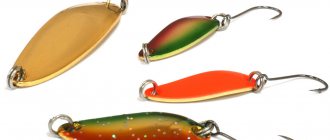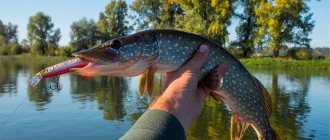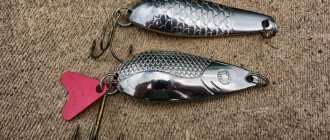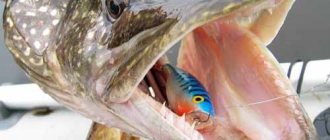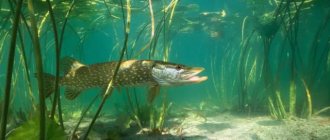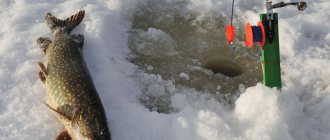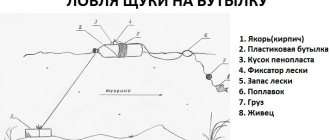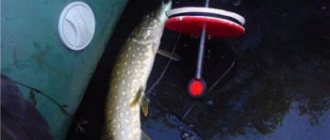The bait that catches everything, everywhere
Castmaster is a unique bait, a “universal soldier.” He catches fish on a high-speed straight line, he fishes with a stepped jig, in a plumb line from a boat, he also fishes from the ice in winter, he also fishes in the sea at great depths. It has excellent ballistic characteristics, is almost not subject to mechanical damage and corrosion, because it is made of galvanized metal.
If I were asked to choose one single bait with which to go fishing, I would not take an expensive wobbler, spinner or jig bait, but would choose a castmaster from the American company Acme. Recently, it has become for me not only the best bait, but also a kind of “litmus test”.
My list of “victims” of the castmaster also includes lovers of great depths: pike perch and bersh, and pike, which lives everywhere, and of course perch, and asp with ide, and even completely non-predatory fish, such as roach, saberfish, bream, and silver bream. And recently, on the rolls near Astrakhan, catfish weighing up to 5-6 kg became victims of castmaster. All that remains is to catch your favorite chub with it, and the list will be completed...
One day we were fishing at the Uglich Reservoir. The fishing pattern was familiar - in an area of the reservoir known to us with a characteristic topography, where a school of “forage” fish had already been found, we moved in boats along the slope into the Volga channel, making control casts, and waited for the daytime release of the pike perch. The “fanged ones” appeared almost on schedule, but my baits attacked occasionally, without being detected, while at the same time my friend pulled out one pike perch after another. I patiently changed the color of the twister, reduced its size - again zero. The foam rubber did not bring success either. Another pike perch pulled out of the water by a friend made me swallow my fishing pride and ask what he was fishing for. It turned out to be a castmaster. I was a little confused: firstly, at that time I did not have a native castmaster in my arsenal, but tried to fish only with homemade ones from a “birdie”; secondly, I never believed in this piece of hardware; and thirdly, then I mistakenly believed that if you fish from the bottom with stepped wiring, then the fish does not care what object it attacks - plastic, foam rubber or metal. But that day the fish only bit on the castmaster. Here you will inevitably believe in its catchability and unique properties.
Description
The Castmaster spinner (original) is an oblique cut of a cylindrical metal rod made at a certain angle. Initially, five varieties of bait were produced weighing 7, 14, 21.28 and 35 grams. Currently, models weighing from 2.5 grams have been added to them.
At the top there is a hole in which the winding ring is fixed. It is designed to connect the bait to the main fishing line. A treble hook is attached to the bottom hole.
Experienced fishermen usually remove the top winding ring immediately after purchase to avoid accidental loss of the bait and improve its already excellent aerodynamic characteristics. It is also recommended to replace the tee immediately, because the hooks on it are usually blunt and very difficult to sharpen. The size of the hooks is chosen depending on the type of fish on which they are installed. You can attach a thread, a piece of wool or lurex to the tee to attract the attention of a predator. The original bait has a silver color.
Collection of information
So I had to start collecting information about the castmaster. I’ll say right away that I didn’t find anything interesting for myself in the fishing literature. From the works of some authors, one could safely remove the word “castmaster” and insert any other word, for example, “front-loaded turntable,” and this would in no way affect the semantic content of the text. I had to “torture” the spinning athletes I knew, and a lot of interesting things turned out.
At one of the major all-Union competitions, Andrei Izotov, using this bait, managed to take first place - he caught several very large perches using the castmaster. At other competitions held on the Mologsky Reach of Rybinka, almost all qualifying perches were caught only with castmaster, and the large perch ignored other baits. Somehow it was the castmaster who helped Muscovite Arkady Fomichev become the champion of the tournament in Yuryevets...
But at the same time, it turned out that the number of anglers who know how to fish with castmaster is not just small, but negligible! For the most part, spinning anglers associate this bait with straight-line fishing, and in vain.
“Smart” bait that requires effort to master
It’s a big mistake to think that this lure is easy to use - this opinion has forced many spinners to abandon the castmaster and return to the usual silicone, foam rubber, etc.
Cas is a spinner that requires considerable effort from the spinner to master it. A clear understanding of what happens to the spoon underwater, at what point the fish prefers to attack the castmaster, etc., comes only with experience.
Once we were fishing on Rybinka on the Volzhsky Reach. In the pre-dawn hours, we found several local places of perch aggregations using an echo sounder and entered into the navigators. During breakfast, I expressed my thoughts to my friends about the desirable use of castmaster in the current conditions, but disbelief was written on the faces of my friends - the variety of available “rubber” should have solved the “perch” issue positively anyway.
At first, my neighbor on the boat also couldn’t catch with the castmaster, who fussed too much, and besides, his too long and soft spinning rod did not meet the fishing conditions. However, a step-by-step explanation of the correct actions allowed my partner to begin successfully catching perch mixed with small pike-perch within 30 minutes. Moreover, the fish bit on almost every cast! At the same time, two other very experienced “jigging” crews arrived at the camp with absolute zeros...
Is it possible to fake a castmaster?
By trying to accurately counterfeit this bait with commercial intent, the “pirates” are wasting their time. They make a completely different lure, with different performance characteristics. After all, similarity does not mean catchability, since when making a fake, the main idea that is inherent in the castmaster is lost - to depict a small fish hit by a predator on the surface, falling very naturally to the bottom.
For this purpose, Art LaValle came up with not only a geometrically accurate shape of the bait, not only its center of gravity was precisely selected, but also a special metal alloy of a certain density was developed, which made it possible to make a fall-gliding in the water column in such a way that it is impossible for a “double” to repeat. Other baits of a similar shape immediately fall into a tailspin and are mainly suitable for near-surface high-speed retrieval when catching asp. These products can also set records for casting distance.
What is the Kastmaster spinner
Castmaster spinner is a fishing bait that is one of the varieties of oscillating spinner, which is used both for spinning fishing and for vertical fishing.
Its classic version is made of a metal rod made of a special alloy, cut at an angle of 17 and 23 degrees and equipped with a winding ring to which a treble hook is attached. The outside of the spoon is coated with galvanic protection, and the hooks of the tees are coated with anti-corrosion protection. It can have a wide variety of colors and be equipped with additional elements.
Photo: Spinner Kastmaster original
The original version of this bait is produced by the American company Acme Tackle. It was founded by Henry Lavallee, who, together with his brother, was engaged in polishing and galvanizing jewelry. Henry invented the Kastmaster spinner by modifying one of the wobblers, the rights to manufacture and sell which he bought from the Eda fishing company.
Dimensions, weight
The length of the bait depends on its mass. Classic weight options in grams are: 7 (4.5 cm), 14, 21 (6.2 cm), 28 and 35. They also produce small models 2.5 (3.2 cm) and 3.5 g, as well as heavier spoons up to 56 g (2 oz). Weight distribution and dimensions may vary from manufacturer to manufacturer.
Playing in the water
The castmaster has a special geometric shape, a calculated center of gravity and a special material. Thanks to this, his game resembles a wounded fry who gradually falls to the bottom. This spinner has an average frequency and amplitude of oscillations.
For what kind of fish?
Catching asp with castmaster
Kastmaster oscillating spoons are used primarily when catching asp on a spinning rod, but are also suitable for fishing other predatory fish. So the catch can often include: perch, pike, chub, pike perch.
Almost all types of medium and large fish bite on this spoon of different weights with different types of bait movement. So, what is caught:
- Asp – bait weight up to 56 grams, fast uniform or wavy retrieve;
- Perch – up to 14 degrees, slow, uniform retrieve;
- Pike-perch, catfish, pike - classic jig step-by-step;
- Salmonids – trout, grayling, etc.
How to distinguish a real castmaster from a fake
I don’t think that Chinese craftsmen will ever fake a castmaster to zero. In addition, the Chinese never set out to copy anything exactly. But spinning anglers who want to not only cast bait far, but also hold the fish they catch in their hands, must be able to distinguish a fake from an original when purchasing.
Winding rings. The main and simplest difference between a real castmaster and a fake is the winding rings, which are cut obliquely and inward. In fakes, they are bitten off perpendicular to the turns of the wire. To make a custom-made winding ring, you need a special, expensive cutting machine. Moreover, the cutting line of the original itself is very smooth, without burrs.
The hooks of fakes are always blunt and often shiny, while the hooks of the original are matte, well sharpened, with a special coating for salt water.
Printing house. Counterfeits always have sloppy packaging and crooked typographical inscriptions. The plastic on the packaging of a fake is almost always wrinkled around the perimeter and glued crookedly.
Dimensions. In addition, for obvious reasons, counterfeiters do not make baits for castmaster in small and very small sizes - this is simply impossible to do in artisanal conditions. And in the best case, you will find a “Chinese” on sale weighing about 14 g, but never less than 7 g.
Quality of surface treatment. If you compare the original and the fake, it’s immediately clear what I’m talking about. A real bait's surfaces are not only coated with shiny galvanization, but also perfectly polished.
And the simplest advice on how to buy the original is to purchase baits only in specialized stores where the entire line of castmasters is on sale - from 2.5 g and above.
Making castmaster spinners with your own hands
Many skilled fishermen want to save on the purchase of baits and make catchy working copies in artisanal conditions. The Kastmaster spinner is no exception.
Manufacturing methods
- Sawing down a metal rod.
- Metal casting.
- Casting in plaster mold.
For this method you will need: a vice, a metal rod and a hacksaw (or grinder). The rod is taken with a diameter of 10-20 millimeters, but you can choose a different diameter. It all depends on your preferences. The material of the rod can be different - iron, aluminum, copper, stainless steel.
However, remember that the bait will come into contact with water, and therefore ordinary iron will quickly rust. Aluminum and copper are susceptible to oxidation, so stainless steel is a good option because it does not corrode and has a metallic sheen.
We fix the rod in a vice and cut off the excess parts at an acute angle. Then we dull the sharp edges with a file so as not to cut ourselves and not to cut the fishing line in the future. We clean the treated surfaces with sandpaper.
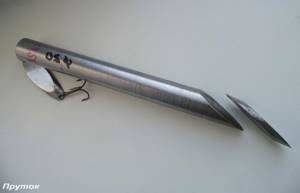
After rough operations we polish our product. Along the edges of our spoon, holes are drilled for winding rings to attach the bait to the fishing line and attach the tee. The Kastmaster spinner is ready!
Metal casting
For this method you will need a metal tube. The material of the workpiece is basically not important. The shape is sawn off at sharp angles, which the spinner will acquire in the future. The difficulty is that the form must fit tightly to the surface on which the pouring will take place. After you have placed the form on the surface, start pouring.
Lead or tin are suitable for this. They have a good weight and are easy to handle. After pouring, the metal form is carefully sawed. If after pouring there are uneven surfaces and edges, file them. Then holes for the winding rings are also drilled, and the spoon itself is cleaned with sandpaper and polished (or painted).
Casting in plaster mold
The advantage of this method is that it is much easier to make the mold, because plaster is easier to process. The shape of the future spinner is “cut out” in plaster. This must be done carefully, since gypsum is a fragile material.
The inner surface where the material will be poured should be so smooth that after you break the mold, a minimum of irregularities remain on the surface of the spoon.
This will simplify the final finishing of the bait in the future. Once the mold is ready, start pouring. Lead or tin are also suitable for this. After pouring, the mold is broken, the edges and surfaces of the part are smoothed with a file, sandpaper, and holes are drilled along the edges.
Some subtleties and required wiring speed
Often, many anglers position this spoon as the main “specialist” for catching asp. Mostly riding and most often gregarious. That is, these anglers are not using the most valuable vertical component in the bait game.
But in this article I don’t want to consider the rather primitive fishing for an apex school predator using kastmasters - in this fishing, in my opinion, there are only two simple tasks. The first is to silently approach the place where the fish are fighting, the second is to cast the bait as far as possible. In this type of fishing, anyone can be a successful fisherman - both a master and a beginner, and almost any bait is suitable here - Chinese pieces of iron “castmaster” and homemade “cuts” from a metal rod, and even a simple nut with a tee tied to a cord!
But when catching passive fish from the bottom at medium and great depths, these same “some subtleties” arise when it is necessary to use both the vertical vector of the bait and the horizontal during one retrieve.
The first phase of retrieving is understandable - it is the same for almost all deep-sea lures: cast, close the bow, taking out the slack in the line, and wait for the spoon to fall to the bottom. The most difficult part comes next - how to properly animate the bait already lying on the bottom, and then catch the necessary rhythm of movement when retrieving. In addition, all phases of wiring have their own subtleties.
For example, such a point as speed, which is important when fishing with all types of baits, often comes to the fore when using a castmaster.
It happens that fish attack the bait only at the minimum speed of the retrieve, and you need to catch exactly that pace, which is necessary and often the only correct one, so that when retrieved, the spoon “rests” on the water, and does not fall through or go sideways. Only a slow speed in many situations will help provoke a passive predator to bite.
The question often arises: how to start retrieving a bait lying motionless on the bottom? Turning the reel handle? Short or long hooking with a spinning rod? And the length of the pause is also important. It happens that 2 seconds pass and the fish doesn’t bite. And you pause for 4-5 seconds, and immediately see a positive result.
Tackle for lure fishing
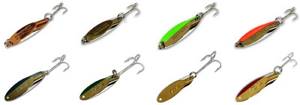
The selection of gear for fishing with Kastmaster is determined, first of all, by the object of the spinner’s hunt, and secondly, by whether fishing is done from the shore or from a boat. How to determine the parameters of a spinning rod depending on the object being fished?
Asp
It is believed that Kastmaster is a spoon primarily for catching sheresper, although in reality this is nothing more than a misconception. Simply due to its unique aerodynamic characteristics, it is the Castmaster that can be delivered to the “battle zone” of a cautious predator, remote from the fisherman.
And his game when retrieved at any speed is most reminiscent of the movements of the hunting objects of a river “torpedo”. Accordingly, for asp fishing, the longest rods of fast and medium-fast action with good range are used. The test is selected based on the mass of the spinner. The latter usually ranges from ¼ to 2 ounces.
Perch
For catching perch, small Castmasters (1/12-1/4 oz) are usually used. Perch in “cauldrons” is caught in the same way as asp, delivering the bait to the “fighting” zone and leading it with a uniform retrieve. Another method of catching perch is various variants of jig wiring. To catch perch, you can use spinning rods 7-9 feet long with a test weight of 7-14 g. Extra-fast action is not recommended, since the weak lips of the striped predator often tear when fishing.
Zander
Pike perch prefers jigging with variations. The rod must have an ultra-fast action in order to be guaranteed to break through the hard jaws of a predator when hooking and ensure trouble-free fishing.
Pike

When fishing on Castmaster for medium-sized salmon, such as grayling and trout, light and ultralight class spinning rods are used.
Expert opinion
Knipovich Nikolai Mikhailovich
Zoologist, hydrobiologist. I am interested in fishing at a professional level.
Important! If, when fishing with Castmaster, a spinning angler must feel contact with the bottom, then the rod must have high sensitivity. The latter property will be indispensable for recording cautious bites from passive fish.
A reel for fishing with Castmaster should lay the line or cord evenly and not drop the loops when casting and retrieving. In addition, you should pay attention to the speed at which the fishing line is wound onto the reel spool, i.e. gear ratio, since under certain conditions the winding speed can play an important role.
Choosing a spinning rod for a castmaster
This is a very subtle point. Firstly, I’ll say right away that there should be several spinning rods, covering the entire line of baits with their tests. Because often only small-sized castmasters catch passive fish, while heavier ones do not. And for light bait you need a spinning rod with a certain test. For bait of the next weight, you also need your own spinning rod, and so on, depending on the depth of fishing and the speed of the current.
Let’s assume that the main topography of the reservoir where we are fishing is underwater mounds, ravines or vast plateaus next to the riverbed—feeding outlets for schools of pike-perch, bersh and perch, and the traditional “jig” weights that are used in these places are 10-14g. According to my feelings, regarding the upper limit of the test of the rod, for such conditions I take a spinning rod 7.0-8.0 feet long with a test of 12-14 g for baits, if I use a 14-gram castmaster for fishing, and a test for a cord of 6- 10 lbs.
If fishing is carried out at shallow depths or the perch is at half-water, I use bait weighing 7 g or less, and an appropriate spinning rod. A fast action spinning rod with a thin flexible tip is best suited for castmasters.
. Working in the upper range of the spinning rod allows you to better feel the play of the bait - most of the top of the blank is bent under load, and due to this, the separation of the bait from the bottom is smooth, and the phase of falling and “fluttering” in the water column turns out to be continuous, visually close to falling to the bottom stunned fish.
That is, when the forward thrust stops (during the falling phase of the bait), the tip of the spinning rod does not stop working, fully straightening in one second, but is constantly under load, which allows you to be in constant contact with the bait, and clearly works in time with the bait, tracking it work. After all, fish are often caught precisely during the falling phase, and the loaded tip of the spinning rod helps to reliably detect it. To put it simply, the tip of the spinning rod at this moment plays the role of a nod and a kind of hooker. That is why it is important to accurately select the weight of the bait for the depth - here, as with jig fishing, it is not possible to use heavy baits at small and medium depths - the castmaster must hover in the water column for as long as required in a given place, and its weight must be optimal (and often - minimal) for a specific bottom landscape.
In addition, very often, if not always, a passive perch needs the bait to have clear contact with the ground. The perch approaches the gliding castmaster, but does not dare to attack it. The “dying fish” lies motionless on the bottom, but then suddenly comes to life in a brazen manner and tries to escape. The perch is no longer able to withstand this behavior of the prey and attacks the bait. If a spinning angler uses too coarse tackle for fishing, then it will not be possible to “catch” the desired contact with the ground.
Where and when is castmaster used?
They fish with it in different conditions: at stakes or on rivers with strong currents, from the shore or from a boat, and also from ice in winter.
Open water fishing
The method of using the spoon differs depending on the season. This is due to the behavior of fish at different times of the year.
in spring
At the beginning of this season, the fish are on the bottom, so stepped fishing is suitable for castmaster fishing, when after the spoon falls to the bottom, make half to three scrolls and again allow the bait to fall down, and so on until the bite. In mid-May, the fish rise higher, so you can use the fishing method for the warm period.
In summer
At this time of year, the fish changes its location depending on the time of day: in the evening, when the heat subsides, it is more in the upper layers of the water, so long casts with wiring sliding along the surface are used. During the day, in the hot sun, it goes to depth, so the castmaster is allowed to sink to the bottom, using heavier models.
in autumn
During this season, fish are often caught from the bottom with bait from 28 grams. stepped or uniform wiring in the bottom or middle layer. The fish hunt a lot at this time, so they actively move and move through the water column.
Ice fishing in winter
This is a special type of fishing that uses vertical lures with a castmaster. At the beginning of the cold season, the probability of catching is greater in shallow water - from 2-4 meters, and later you need to drill holes where the depth can be from 6 meters and use heavier spoons. Larger castmasters are suitable for ice fishing because the “hunting” occurs mainly at great depths where there is a current. If the water is cloudy, light castmasters are chosen, and in clear water, dark models are used.
Weight scale and colors
The range of castmaster scales is quite wide and can satisfy both ultralight and heavy jig lovers. As for the color range, it is quite diverse, but officially now the baits supplied to Russia are mainly of the following colors:
- silver;
- golden;
- silver with holographic sticker;
- silver with blue stripe;
- silver with red stripe.
Experts from the Moscow company that supplies Acme baits rightly believe that this color line is quite enough to fish in our country.
Selection of bait size
It is known that a well-fed perch is more likely to catch very small baits. But amazing things often happen to active bass. It happens that these fish attack castmasters only of a certain size. And this size has nothing to do with the size of the “feed” fish. For example, you catch a perch, from whose mouth a small smelt, bleak or other fry literally falls out. Place a castmaster of the same length as the food object, but there are no bites. There is not even an attempt to chase the bait. But as soon as you put the castmaster a size or two larger, without changing anything else, the perches begin to be caught one after another. Apparently, this is connected with the very essence of the behavior of the “striped robber”, who strives to get ahead of his pack neighbors and grab a larger and fatter victim. It is with this greed that I associate the often encountered in practice catching two perches at once with one wobbler.
Fishing in still water
There are many options for wiring a castmaster. But I identify four main phases for myself. And most often, “my” passive fish can be forced to rush to the bait by the sequential use of all four phases in the order in which I describe them.
Wiring Method No. 1
- The fall phase is “vertical”. This is the most wonderful phase, the most valuable thing is how a castmaster knows how to fall and plan. It is the falling wounded fry that is most often picked up by cautious large predators a little away from the bustle of the perch. And most often - at the very bottom or at the moment when the bait has already fallen to the ground and the cord begins to sag. This is a very important point; you must be ready to respond to a bite in time with a hook.
- Pulling phase. If predators do not dare to bite, but are clearly in the splashdown zone of the bait, I usually do this. Before starting to lift the spoon, I drag it along the bottom. The spoon lies on the bottom. Having straightened the cord and slightly extended the tip of the spinning rod towards the spinner, I begin, slightly playing and tugging (as if lifting the head of a stricken fry above the ground), slowly dragging the castmaster along the bottom. The length of such “pulling with twitching” can be different: from 5 cm to 30-40. The bait, raising a cloud of turbidity, swaying and glistening on its sides, often causes a bite from perch and pike perch. If fishing conditions and equipment allow, this “crawl away” of the wounded fry from the predator can be diversified by fine trembling of the spoon: drag the bait along the bottom, and make frequent short vertical movements with your hand, as when fishing in winter from ice with a jig. Such “aggressive” behavior of the prey often ends with a powerful bite from an angry predator.
- The take-off phase of the spinner is the “step”. You can tear the spoon off the bottom in two ways: by turning the reel or tossing it with a spinning rod. It is necessary to decide which method to use, and experimentally find out which wiring and at what height is preferable at this moment (when throwing and jerking with a spinning rod, the upper part of the trajectory graph is higher, sharper than when manipulating the reel), and often changing the beginning of the wiring leads to that other fish are starting to be caught, both in species composition and in size. How to start retrieving depends on whether you are fishing in current or still water. In addition, you need to clearly understand how much cord the reel winds in one revolution, that is, how fast it is. This depends on both the gear ratio of the reel and the size of the spool. But I almost always prefer to tear the lure off the bottom with a jerk of the rod of the required amplitude and speed.
- The phase of rewinding a slack cord. I have already said that often the spoon must move in the water at the minimum possible speed so that during the reeling phase the three forces influencing it are balanced: the vector of the “forward thrust” force, the vector of the “gravity of the earth” and the buoyant force of the water. The fish, which did not dare to attack the “dying fry” in the previous phases, rush to the bait, irritated by the agility of the suddenly “revived victim”.
Simplified wiring method - “American”
The fishing method described above can be significantly simplified (especially when you are dealing with active fish and fishing speed is important) by narrowing it down to two phases. The first is that the rod “looks” at the bait lying on the bottom. Then a fairly energetic upward jerk is made with the spinning rod. In this case, the spinning rod takes a vertical position. At this time, the bait first makes a jump from the bottom to the length of the rod’s swing. The line sags, the bait floats to the bottom. The second - the slack in the fishing line is removed, and the second “step” begins.
The described “American” wiring (we can call it conventionally “bottom jerking”) is perfect for ordinary jig baits, and in general for all baits that can be “put” on the bottom fairly quickly, i.e. fast-sinking (heavy rattlins, oscillating spoons, spinners with a front weight). Jerking the bait often provokes an indecisive predator to attack, and such wiring near the bottom is even more so.
Fishing with a jig "step"
The castmaster can also be used as a jig bait, making quick movements with the reel handle that are already familiar to many spinning anglers while the spinning rod is completely stationary. Yes, such wiring is very primitive in nature. But it is also very effective; in many cases it can be the initial, basic wiring for all types of deep baits. For many fishermen, it is best to start mastering castmaster with jig wiring. And only then, increasing or decreasing the speed, the length of the line, changing the weight of the bait, you will have the correct connection, the feeling of a castmaster under water, you will learn to understand your actions. The main thing is not to rush, but to constantly train and not wait for immediate results. Indeed, in any sport, and in fishing too, the number of repetitions of any exercise is proportional to the skill of its use.
Features of pike fishing on Kastmaster
This bait is not recommended for use where there is a lot of snags and algae on the bottom, because the hooks often cling to what is in the water and there is a high risk of the gear breaking. Castmaster spinners for pike are good in the following places:
- deep holes,
- channel section,
- long ditches,
- edges, rifts and deep slopes.
Castmaster size for pike
When catching this predator, it is recommended to use several sizes of spoons, starting with a universal weight of 14 grams and a medium size. If the fish are not active, you can use a smaller bait, and if there is a chance of encountering a large pike, you will need a larger Kastmaster. You should not immediately use the smallest size spoon, as it may not interest large fish.
Wiring a castmaster for pike
Fishing with castmaster can be done in a variety of ways, such as:
- Uniform, unhurried - suitable for animation both in the headquarters and in a river with a strong current, both in the thickness of the reservoir and closer to its surface.
- Wave-shaped - used in the water column and in the coastal strip.
- Uneven is a method of provoking a sluggish predator to attack the bait, used in different conditions.
- Stepped – suitable for animation at depth, when hunting large individuals in any type of reservoir.
- Ryvkovaya, used mainly in the water column.
Why autumn is the best time to catch pike with castmaster
Before wintering, the predator accumulates nutrients, so it feeds especially actively. It is more mobile, so it can be found both in the water column and closer to the bottom. It is in this range that the castmaster works.
Video: Castmaster fishing for pike
Not exactly a practical master class, but the video gives a clear idea that pike can be caught perfectly with this bait.
The castmaster is a lure that different types of freshwater and sea predators cannot resist, especially when played skillfully. In our opinion, such a bait should be in the arsenal of any spinning rod and winter angler.
Views: 636
Similar articles:
- Spinner for pike. The best lures for catching pike Pike is one of the most popular fish for catching. This…
- The most catchy spinners for pike. Top 10 spinners Don't get carried away by the wide variety of spinners, just a few spinners are enough...
- Catching pike in winter with a spoon. Top 5 best winter lures for pike When cold bodies of water are finally covered with a layer of ice, for many avid…
- Pinwheels for pike. Top 10 most catchy Spinners like “Mepps” are one of the most effective baits...
Fishing in strong currents
Demolition fishing
Fishing on the river allows you to use a castmaster in the same way as a spinner when fishing from the shore, from a boat or by wading - for demolition. We throw a bait of suitable weight under the other bank and, adjusting the process with the spinning-line angle, we fish different horizons. The castmaster, supported by a stream of water, moves in a smooth arc. In the place where the influence of the current weakens (usually at the boundary of the stream and the water), the bait will begin to sink and “catch” the entire thickness of the water. By the way, it is often in such places that fish stand, waiting for food to be washed away here by the current. Naturally, we select the weight of the bait according to the depth, speed of the river and the thickness of the cord, so that the bait does not get stuck at the bottom, but goes a little higher.
With each new cast, you should increase the flight range of the bait, gradually examining the entire accessible sector of the river. In the river area where the bites have started or the first fish has already been caught, you can try to reduce the weight of the bait or switch to other types of baits, replacing the “scout” from the “platoon” of castmasters with a more specialized specialist - a soldier from the “platoon” of wobblers, for example.
Method No. 2
Almost completely repeats the “American” method described above, but the current makes its own adjustments, keeping the bait “afloat”, the fall is much longer. You can diversify the wiring by performing swings not only along one line - straight down as follows. Having tilted the spinning rod to the extreme left (or right) position, the spinner stands facing down the river and, bringing it as close as possible to the water, jerks the rod upward at an angle of 45 degrees. If you do this in still water, you will simply get a straight line in one plane along the line “splashdown point - tip of the spinning rod.” And in a strong current, you will get a very wide arc with a complex trajectory, with horizontal sections of the path during sweeps and “steps” “unfolded” in the vertical plane while falling to the bottom.
When fishing in still water, the bait moves almost in one line, or rather, in one plane. When fishing in a strong current, already at the jerk stage, the bait moves in an arc, being knocked down by the current. And at the second stage - the stage of the castmaster falling to the bottom, it is very strongly carried down by the current from the point of separation to a new point of fall to the bottom, and a “flight” trajectory is obtained. The fishing sector using this method on the current is several times larger than when fishing in a straight line.
This technique allows you to fish “micro-reliefs” away from straight-line fishing, without leaving the same place and, accordingly, without creating unnecessary noise when moving. In addition, fish controlling the upper horizon will respond better to the first part of the retrieve, and bottom fish will respond better to the rest of the retrieve.
"Fluttering" fishing
This method appeared in my practice relatively recently and has shown its complete consistency and effectiveness. It consists of the following. It doesn’t matter how the boat is oriented or whether the fishing is wading - such wiring can be carried out along the drop-off, edge and when guiding from shallows to depth, and vice versa. I throw the bait down - diagonally, over the river bed or other longitudinal depressions, choosing the weight so that it “feels” the bottom with great difficulty. And I begin to make a stepped, wide wiring against the current towards myself - obliquely.
When the castmaster hits a sharp drop in the river, into a hole, stops feeling the bottom and is carried away by the current, you should open the reel arm or switch it to reverse. In the first case, the floating of the bait downstream is controlled by holding the cord between your fingers (everything is exactly the same as when fishing with a wobbler “from yourself”, see my article in RnR No. 5/2007). In the second case, the reel spool rotates, and I slow it down with my hand. Braking is necessary so that the bait does not tumble, but floats in the water column, near the bottom, on its plane on a stretched cord, actively playing at the same time, and its speed is less than the speed of the flow. Only in this case will the castmaster maintain his original game. Not only fish standing in the same horizon, but also bottom predators often react to such a swim of bait along a dump downstream by biting. It was this kind of wiring that allowed me to catch several small catfish on the swells near Astrakhan using castmaster.
Surface jerk wiring
Somehow, purely mechanically, I started fishing with a castmaster. Moreover, in a fairly shallow body of water, it was with jerk wiring that I immediately caught it! Until this moment, none of the predators attacked either the wobbler or the spinner. To be honest, I don’t have enough statistics on such fishing yet, but it’s definitely worth trying to fish this way with a castmaster. It is also necessary to try such near-surface jerking on large bodies of water, adjusting the duration of the pause to local conditions.
Upstream fishing
I often hear the question: “Does the castmaster fish by wiring downstream?” Yes, he does. But in order to at least slightly outpace the jet, you have to drive it down with micro jerks, quickly picking up the slack in the cord. This is very difficult, and such use of a castmaster can only be justified on deep rivers with a sandy bottom, where there are no snags. It’s better to cast the bait a little up and carry it across the current, with slow reeling and touching the bottom.
Castmaster fishing, wiring technique
This type of tackle is suitable for different wiring, both for uniform classic and specific:
| 1. Twitching | After casting, waiting for the tackle to sink to the bottom, it is slightly swayed from side to side. If after a cloud of silt rises during the fall, a bite does not occur, you need to create the impression that a weak fish is trying to break away from the bottom. To do this, the line is slowly pulled up, tugging with the tip of the rod. Even a well-fed predator can trigger the instinct to attack an exhausted prey. If this does not work, you can pretend that the easy prey is leaving. To do this, either reel in the reel, then let the bait drop a little, or periodically toss the rod. |
| 2. Bottom jerk wiring | Heavy castmasters are used for it. After casting, the rod remains pointed at the fallen spoon. Then the spinning rod rises sharply and stays in a vertical position, then the bait jumps up to the length of the rod. After the spoon sinks to the bottom, the cycle repeats. |
| 3. Jig step wiring | After the bait falls to the bottom, the rod is left motionless, and it is lifted from the bottom by rotating the reel. After lowering the Castmaster to the bottom, the action is repeated. In this case, you can change the speed of raising the bait, the length of the retrieve or the duration of pauses. |
| 4. Fishing along a cliff while holding | This method is used when fishing on the current where there are drops and edges. You need to choose the weight of the castmaster so that it barely touches the bottom. The spoon is thrown to the bank opposite in a downward direction and a stepwise retrieve is performed obliquely against the current. The castmaster will begin his signature play if he moves slower than the current. To adjust the speed, you can put the reel in reverse and hold back the speed manually, or lift the line handle and hold the line between your fingers. |
About
Combined equipment
I am not a supporter of using combined equipment. I like to feel even the slightest touch of the fish on the bait. Therefore, I like it when a single bait is tied to the end of the cord, no matter what - a wobbler or a spinner, and the connection “bait - my hands” is as rigid, direct and sensitive as possible. But sometimes you have to give up principles - the fish have become too capricious - and knit all sorts of combinations. One of these simplest combinations is a tandem of castmaster and twister (or wabik, streamer), tied a little higher. This combination allows:
- clearly monitor the bottom, because the fish are still tied to the relief;
- The castmaster, with its play, glitter and noise, attracts even the most aggressive and hungry fish from afar, “collecting” them in the posting area
- Even large predators are caught on the castmaster, and on the upper small twister - all the fish in a row, starting with small perches;
- allows you to quickly identify the preferences of fish at the moment and, if necessary, quickly adjust.
I always place the castmaster on a soft leader made of multi-strand metal material. The leash, 15-20 cm long, is equipped with a swivel at the top, and a carabiner clasp at the bottom for quickly changing the bait. Directly to the upper swivel, on another, but small clasp or on the winding ring, I attach a second, smaller bait - a twister on a double or single, a wabik or a streamer. Of course, with such a workload, the castmaster somewhat loses his original game, but nevertheless he still catches fish perfectly. True, it often happens that the pike wants to try the top bait, cutting off the castmaster too.
Additional "decorations"
Often in the literature you can see in the photo a castmaster equipped at the back, for example, with an offset hook with a twister. Such equipment should help when fishing in supposedly dense snags. But it should be noted that when fishing in deep snags, only surface baits do not cling to underwater branches at all, and the best of them, undoubtedly, are poppers and rubber frogs. You have to understand well that with such equipment, the precisely selected balancing of the castmaster is instantly lost - and instead of swaying and fluttering when diving to the bottom, we see a fast-sinking bait diving to the bottom with its tail - twister up. This combination bait can be used very effectively when fishing with a slow, almost straight-line retrieve, without long pauses - dives. In this case, this tandem has no equal in terms of flight range (and, accordingly, fishing area) and almost does not cling to uneven surfaces on the bottom.
Photo of castmaster
Note!
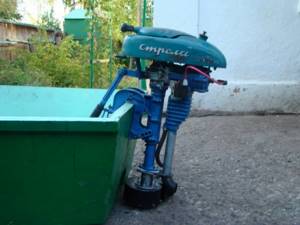
Do-it-yourself boat motor - tips for beginners, projects, drawings and step-by-step description of the construction of the main components and elements (video + 120 photos)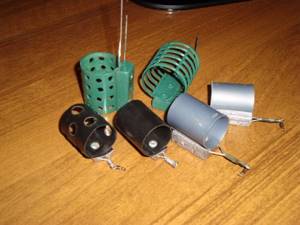
Feeder for winter fishing - secrets of use and techniques for feeding fish in winter (115 photos)
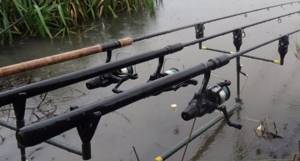
Bottom gear - the most effective types of equipment and features of casting techniques (95 photos and videos)
Read here Fishing chair - tips on choosing and drawings for making a chair yourself (95 photos)
Help the project, share on social networks 

0
Disadvantages of a castmaster
Of course, I am not satisfied with the hooks - maybe they are good for the sea, but they are not very suitable for my river fish - there are a lot of hooks. And often I replace the original hooks with Owner or Gamakatsu. I use different tee sizes for the same castmaster size - for catching perch I use a size smaller than the original, and when fishing for pike perch and pike - either the same ones, or I increase the size of the hooks. It is important that the weight of the hooks is approximately the same and does not change the balance of the spoon. Sometimes, if the fish is passive and only “bales” the bait without being caught, I fish with a castmaster with a homemade brush made of red woolen threads that cover the winding ring and tee.
Tackle for winter trolling
Winter fishing rods for trolling pike perch need reliable and resilient ones. The striped robber grows to impressive sizes. The hook is performed strongly and sharply to pierce its bony mouth. Therefore, the tackle must be strong.

Tees are selected according to the size of the baits. It is better to use high-quality expensive hooks. You can buy a fishing rod for vertical trolling of pike perch at a fishing store or make it yourself. Read more in the article about tackle for trolling pike perch. Winter fluorocarbon 0.25-0.35 mm is usually used as fishing line. An important characteristic is the rigidity of the fishing line. Soft is not suitable for this case. You need to look for the most inextensible fishing line with low memory, or use braid. The use of tensile lines when fishing at great depths leads to failures due to the inability to make a reliable hook.

Winding rings
I have one more small question for the manufacturer - why are some spinners supplied to Russia equipped with two winding rings (that is, one on the tee and the other in the front of the bait), and some without a ring at the beginning?
What is this, the American economy? This causes great inconvenience - you have to look for rings of good quality and large diameter on sale and spend time on equipment. And without such a winding ring there will be no correct play of the spinner. Keep this in mind when purchasing a spinner - all castmasters must have a front winding ring! After all, if you attach a castmaster to the clasp of a leash without a winding ring, then when fishing for large fish (or sharp casting), the clasps often unfasten or unbend (because the castmaster presses with its edge on the wire of the narrow fastener). Both the fish and the bait are lost. Share
Spinner kastmaster
Kastmaster has several main sizes and, accordingly, weights: seven, fourteen, twenty-one and thirty-five grams. The set includes a winding ring with a tee. In some cases, the castmaster comes with a reflective sticker. The classic color is considered silver. The size of the tee must match the size of the bait. In other words, it should be approximately equal to its width.
The castmaster spinner does not need to be equipped with an additional front winding ring or carabiner, since in this case it will not play correctly and will float on one side . You can tie the castmaster to the main line with a special tightening knot. However, in this case, the problem of chafing of the fishing line may arise, so the best option is to install a tungsten leash, which will be attached to the spinner using a loop-to-loop method. A swivel is placed on the leash on the side opposite the spinner. The length of the leash should be approximately twenty to thirty centimeters.
